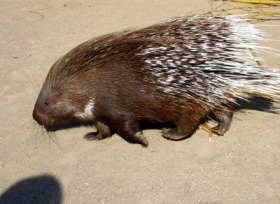Habitat

The red areas are where porcupines live.
Porcupine habitats varies geographically and they use a variety of habitats too. They can live in open tundra; deciduous, taiga or boreal forests; grasslands;and desert chaparral. Porcupines live in the Americas, Europe, Africa, and Asia.
Porcupines can live in trees to the ground. The amount of time porcupines spend on the ground depends on how much food there is and protection from predators. When there isn't enough plants on the ground, porcupines spend most of their time in trees. In the winter, porcupines prefer to rest in rock dens on the ground, but if they are not available, they will choose trees. Depending on their feeding and resting needs, porcupines will choose different trees. Hemlock trees are one tree porcupines live in because they have very thick foliage and high nutritional value.
Porcupines can live in trees to the ground. The amount of time porcupines spend on the ground depends on how much food there is and protection from predators. When there isn't enough plants on the ground, porcupines spend most of their time in trees. In the winter, porcupines prefer to rest in rock dens on the ground, but if they are not available, they will choose trees. Depending on their feeding and resting needs, porcupines will choose different trees. Hemlock trees are one tree porcupines live in because they have very thick foliage and high nutritional value.
Symbiotic and Human Relationships

Porcupine on a road.
Symbiotic relationships that porcupines have are good and bad. A good symbiotic relationship is the microorganisms in a porcupine's stomach help break down plants that were eaten into a usable form, just like us. However, in the Great Basin, a population of porcupines are near extinction because of an increase in moutain lion predation. This happened because other prey species decreased in numbers. Also,in the Rocky mountains porcupines live with wood ticks. Porcupines play a significant role in the life cycle of these ticks, and infestation may be harsh.
The relationship between porcupines and humans haven't been very well. The porcupines' salt cravings usually lead them to chew on housing structures, automobiles, and things made with plywood or with salt residue on it. They also make a bad impact on the timber industry because they feed on trees, making the trees unsuitable for lumber. Most people think porcupines are a pest, while others think they are good for research and study.
The relationship between porcupines and humans haven't been very well. The porcupines' salt cravings usually lead them to chew on housing structures, automobiles, and things made with plywood or with salt residue on it. They also make a bad impact on the timber industry because they feed on trees, making the trees unsuitable for lumber. Most people think porcupines are a pest, while others think they are good for research and study.
Conservation and Life Span

A porcupine quill lampshade.
In the past, porcupines have been killed by hungry natives, trappers, and miners. Today, although hunting season is open all year with no bag limit, many people do not kill porcupine without reason, because of the past. Some people think the meat is too strong. while in some areas think of it as a delicacy. Instead of killing the animal for its quills, today natives corner them and tap their back using a styrofoam paddle to get the quills. Then the natives use the quills for decoration. Porcupines can also be harmful to commercial forests and reforestation projects by feeding on the growing buds or bark all the way around trees. When these problems happen, site specific control is called when necessary. However, bounties, large poisoning efforts, and unregulated killing have been recently discontinued. The conservation status of porcupines are some species are threatened, but most are classed as 'Least Concern.'
On average, porcupines live up to about 6 years in the wild. But they can live up to 18 years, since porcupines are relatively long-lived animals. Porcupines that are over 12 years show decreased feeding and are probably smaller in size.
On average, porcupines live up to about 6 years in the wild. But they can live up to 18 years, since porcupines are relatively long-lived animals. Porcupines that are over 12 years show decreased feeding and are probably smaller in size.
